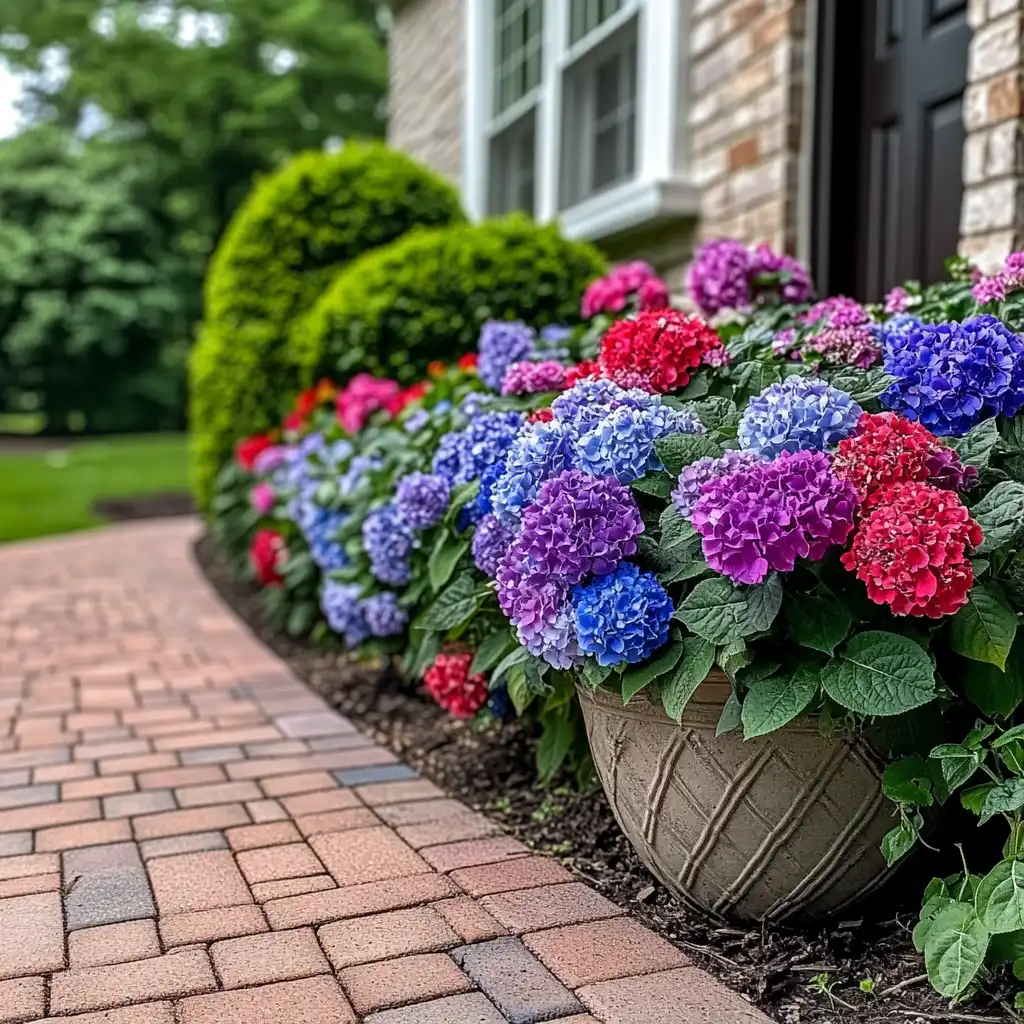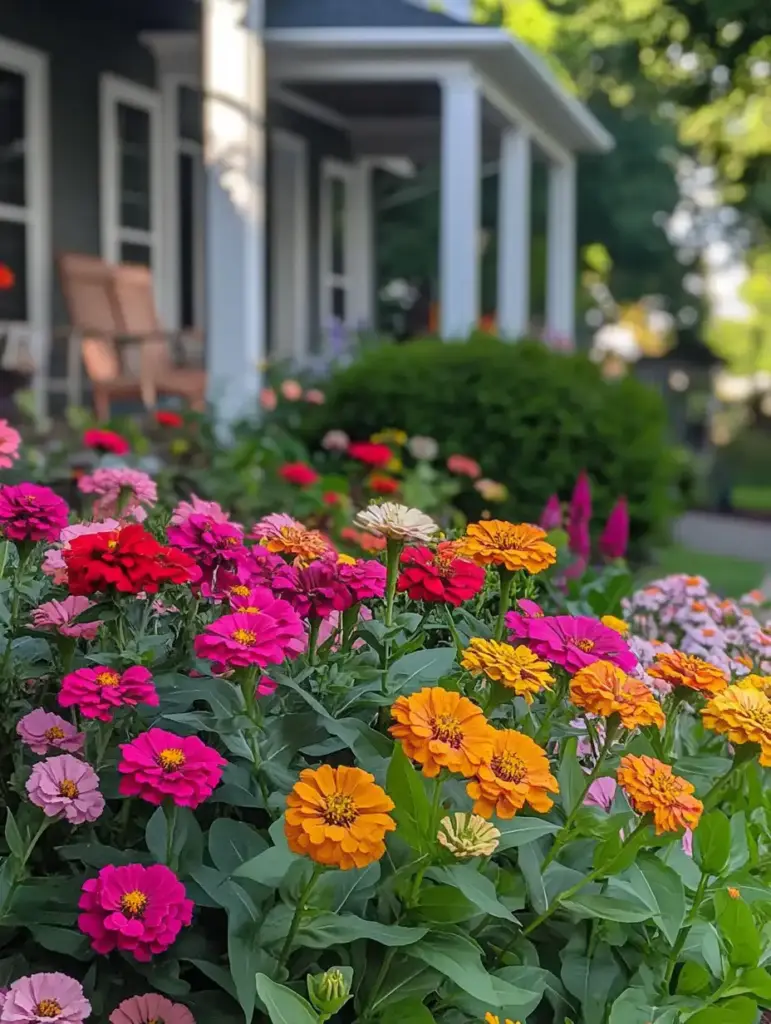If you’re looking to refresh your outdoor space with vibrant colors and captivating textures, exploring fresh flower garden ideas is a fantastic place to start. Whether you have a sprawling lawn or a cozy patio corner, the right design can elevate your landscape with seasonal blooms, enhance curb appeal, and even support local pollinators. For example, you might take inspiration from these backyard flower garden ideas to bring new life to your green space.
Designing a successful flower garden goes beyond just picking pretty petals—it involves careful planning around sunlight exposure, soil conditions, drainage, and incorporating shrubs or hardscape features for structure. Resources like our guide to raised bed gardening mistakes to avoid can help you avoid common pitfalls as you plan your layout.
In this guide, we’ll explore 18 creative and practical concepts to spark your next garden transformation. From charming cottage-style flower beds to bold, colorful borders, each idea brings a fresh way to express your outdoor style.
Table of Contents
1. Uplift Your Farmhouse Facade
One of the most classic flower garden ideas is to frame the front of your home with bold, blooming colors—and nothing does that better than a mix of hydrangeas, chrysanthemums, and roses. This approach not only adds texture and seasonal interest but also creates a warm, welcoming atmosphere right at your doorstep.
🌼 Key Elements:
- Hydrangeas for their large, fluffy blooms and long-lasting summer color
- Chrysanthemums to bring autumn warmth with rich hues of red, yellow, and orange
- Roses for timeless elegance and fragrance
🏡 Design Tips:
- Line these plants along a stone or gravel pathway to soften the hardscape and guide guests to your entryway.
- Use a mix of heights, placing taller shrubs near the walls and layering shorter blooms in front for a full, lush look.
- Incorporate evergreens or ornamental grasses as structural backdrops that highlight seasonal flowers.
This idea is perfect for homes with traditional or rustic charm, but you can easily adapt the palette and layout for more modern facades by opting for minimalist containers and a simpler color scheme.
2. Create a Border with Colorful Flower Edging
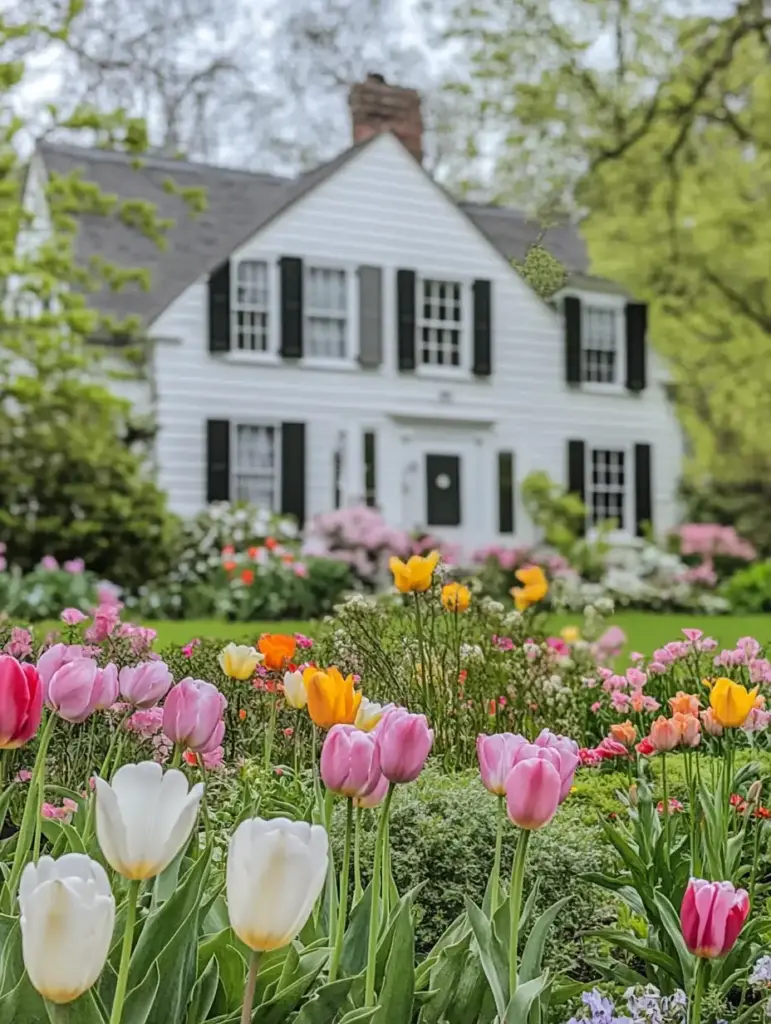
When you’re brainstorming functional yet eye-catching flower garden ideas, don’t overlook the power of a well-defined flower border. This approach adds instant structure and polish to any yard by framing your lawn, driveway, or garden beds with a ribbon of vibrant blooms.
🌸 Key Elements:
- Tulips and asters for a mix of spring and fall color
- Salvia for spiky purple accents and pollinator appeal
- Daisies for cheerful white and yellow pops
🧤 Design Tips:
- Choose a color scheme that complements your home’s exterior—think bold contrasts or soft, pastel palettes.
- Plant in staggered layers with taller plants at the back and shorter varieties toward the edge to enhance visibility and texture.
- For year-round interest, alternate annuals and perennials so that something is always blooming.
This style suits homes with a formal or suburban garden layout and is especially effective along fences, pathways, or the perimeter of a lawn to tie your landscaping together.
3. Go Colorful and Bold with Layered Blooms

Bold, vibrant gardens don’t have to be chaotic. With thoughtful structure and color coordination, you can create an energetic flower display that still feels cohesive. This is one of the more daring flower garden ideas, ideal for gardeners who want their landscape to make a memorable statement.
🎨 Key Elements:
- Shrubs like boxwood or dwarf lilac to provide green anchors and shape
- California poppies for eye-popping orange and yellow tones
- Catnip and perennial sage to balance the palette with purples and silvery greens
🛠️ Design Tips:
- Use evergreen shrubs or ornamental trees as a backbone, then fill in with colorful perennials around them.
- Stick to a color wheel strategy—pair complementary or analogous hues for visual harmony.
- Consider bloom times to ensure consistent color throughout the growing season.
This garden style works well in larger yards or corner lots, where you have space to play with volume and bold color contrasts. It’s also a great way to attract bees and butterflies while making your garden feel alive and dynamic.
4. Add Some Mulch for Contrast and Plant Health
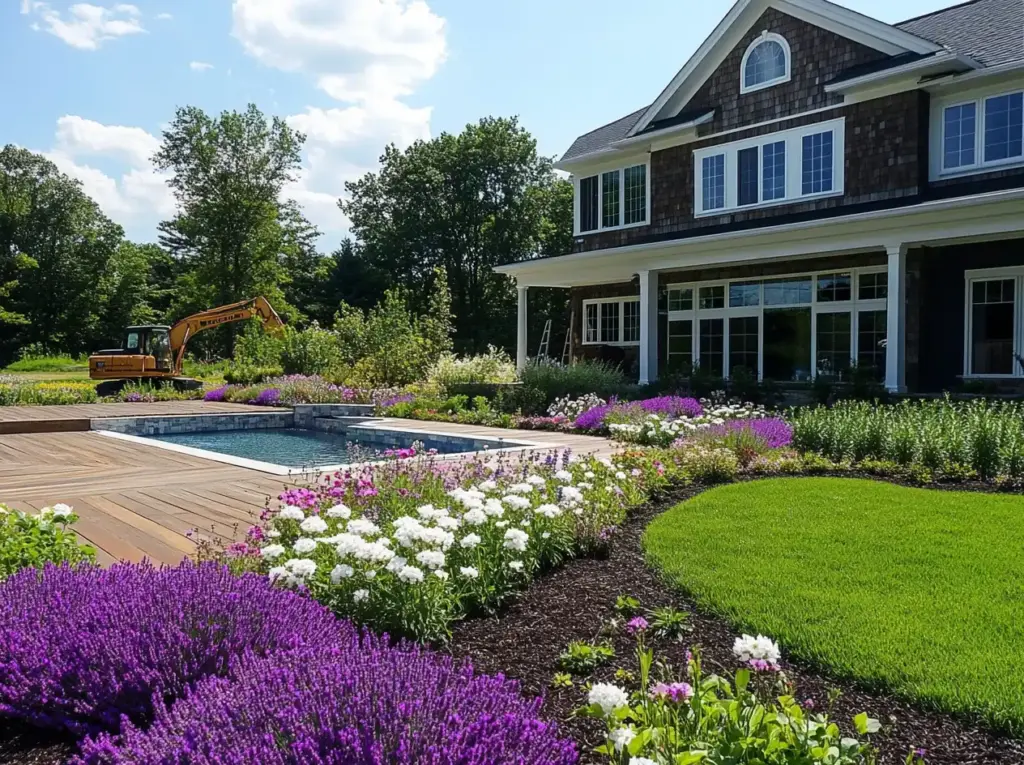
One of the simplest yet most effective flower garden ideas is to use mulch—not just as a practical ground cover, but as a design element. A rich brown or black mulch base creates beautiful contrast against vibrant flower colors, making your blooms pop visually while also improving soil health.
🌿 Key Elements:
- Dianthus and lavender for compact blooms with eye-catching color
- Sage for its silvery foliage and pollinator-friendly flowers
- Mulch (brown bark or cocoa hulls) for retaining moisture and suppressing weeds
🌻 Design Tips:
- Use mulch as a unifying element between flower beds and hardscaping features like patios or walkways.
- Refresh your mulch annually to keep colors vibrant and nutrients high.
- Choose mulch color based on your flower palette—dark mulch for lighter flowers, or red mulch for earthy, warm-toned blooms.
Besides its aesthetic benefits, mulch helps regulate soil temperature and supports healthy root systems—making it a must-have for both seasoned and beginner gardeners.
5. Adopt Raised Gardens for Beauty and Functionality

Raised beds aren’t just practical—they’re also a stylish way to elevate your garden design. Among the most versatile flower garden ideas, raised gardens allow for better drainage, easier maintenance, and creative combinations of flowers and even vegetables.
🌼 Key Elements:
- Alliums for their bold, spherical blooms that attract pollinators
- Marigolds or nasturtiums to naturally repel pests and add color
- Vegetables like lettuce or kale for a mix of utility and ornamentation
🪴 Design Tips:
- Use wood, metal, or concrete planters to match your landscape style—rustic for cottages, sleek for modern spaces.
- Group flowers and vegetables that share similar light and water requirements.
- Layer tall flowers in the center or back of the bed, with low-growing varieties around the edges for a cascading effect.
This approach is ideal for those working with poor soil or limited space. Raised beds also make gardening more accessible and provide a neater, more defined garden layout.
6. Walk in Serenity with Bloom-Lined Pathways

If your goal is to create a tranquil escape in your own backyard, designing a flower-lined walkway is one of the most serene and soul-soothing flower garden ideas. It turns an ordinary path into a floral journey—one that gently guides you through textures, colors, and seasonal fragrances.
🌸 Key Elements:
- Petunias for their long bloom time and wide range of colors
- Lavender for its calming scent and pollinator appeal
- Ornamental grasses to add softness, movement, and height variation
🚶 Design Tips:
- Curve the pathway slightly to create a sense of discovery as you walk.
- Use stone, gravel, or stepping stones as a base for a more natural, rustic feel.
- Combine different textures (e.g., feathery grasses, soft lavender) for depth and dimension.
This garden idea works beautifully in both large landscapes and smaller yards. Even a narrow passageway can be transformed into a peaceful retreat with the right flower and plant pairings.
7. Highlight Curves with Strategic Planting

Curved garden beds and winding lawn edges add elegance and fluidity to any outdoor space. Among the more artistic flower garden ideas, this concept uses flowers to emphasize and enhance the natural contours of your yard, creating a sense of movement and visual interest.
🌼 Key Elements:
- Helenium ‘Salsa’ for fiery red and orange tones that energize the landscape
- Nicotiana (flowering tobacco) for height and fragrance, especially in the evening
- Curved borders or pathways to define the planting area and guide the eye
✨ Design Tips:
- Use curved lines to separate lawn from flower beds—gentle, sweeping arcs look more natural than sharp angles.
- Mix upright and billowy plants to accentuate curves without overwhelming them.
- Repeat colors or plant types along the curve for rhythm and cohesion.
This idea suits both formal and informal landscapes. Whether you’re designing around a pool, patio, or garden slope, highlighting curves with the right plants brings a designer touch to your flower garden.
8. Add Some Height for Dynamic Dimension
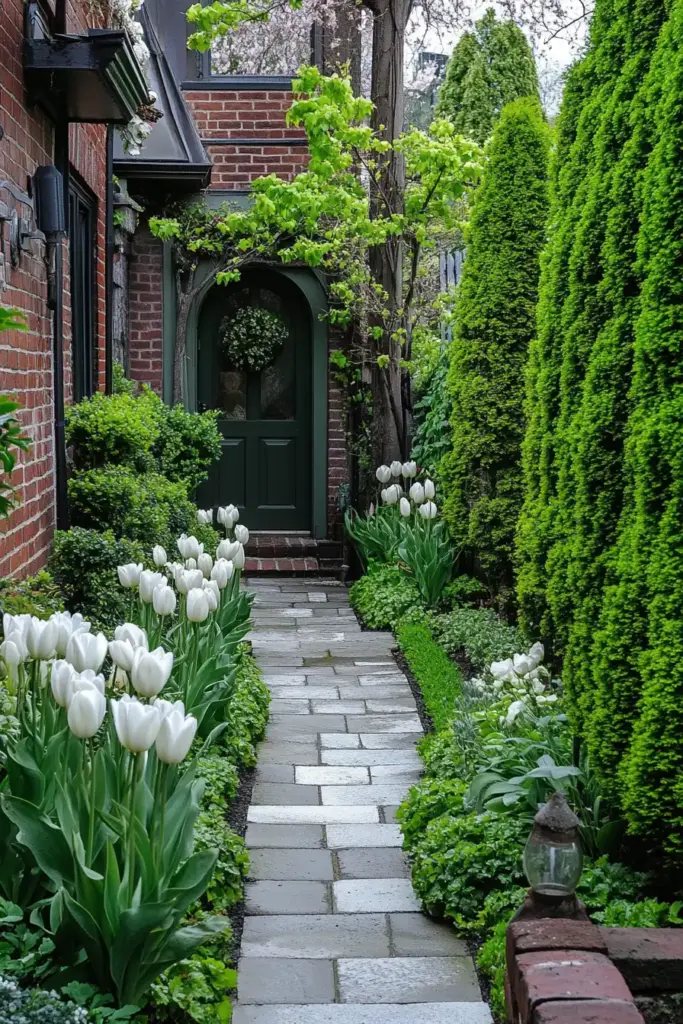
Want to take your garden from flat to fabulous? Playing with height is one of the smartest flower garden ideas to add depth and drama to your landscape. Tall plants and vertical elements draw the eye upward, giving even small spaces a sense of grandeur and layered interest.
🌿 Key Elements:
- Evergreens like Italian cypress or dwarf conifers for vertical structure
- Tall flowering shrubs such as spiraea, viburnum, or osmanthus
- Vertical bloomers like tulips, pansies, impatiens, and Francoa
🪴 Design Tips:
- Place taller plants at the back of beds or along fences to act as natural screens or backdrops.
- Mix in wall-hugging climbers like creeping fig or clematis to soften vertical surfaces.
- Use height to frame entrances, patios, or pathways for added visual focus.
This style is particularly effective in narrow garden beds or small yards, where vertical gardening maximizes space without crowding the ground level. It also adds elegance and creates a lush, enveloping feel.
9. Soften Your Landscape with Trailing Blooms

If your garden features hardscapes like stone patios, walls, or walkways, softening these edges with low-growing, spreading plants is one of the most graceful flower garden ideas. Trailing blooms blur harsh lines and add a gentle, cottage-like charm to structured areas.
🌸 Key Elements:
- Phlox subulata (creeping phlox) for its dense carpet of blooms in spring
- Crackerjack dianthus or similar varieties for bold pops of color
- Natural stone or reclaimed materials to contrast with delicate foliage
🧱 Design Tips:
- Plant trailing flowers at the edge of patios, garden beds, or retaining walls for a cascading effect.
- Use different textures—soft petals, spiky foliage, trailing vines—to add visual interest.
- Combine complementary shades (e.g., pinks and purples) for a seamless, romantic palette.
This method is especially effective in formal gardens that need a bit of softening or in rustic landscapes where nature is encouraged to take the lead. It’s also ideal for smaller gardens where horizontal space is at a premium but vertical or edge areas are available to enhance.
10. Embrace English Garden Style for Romantic Abundance
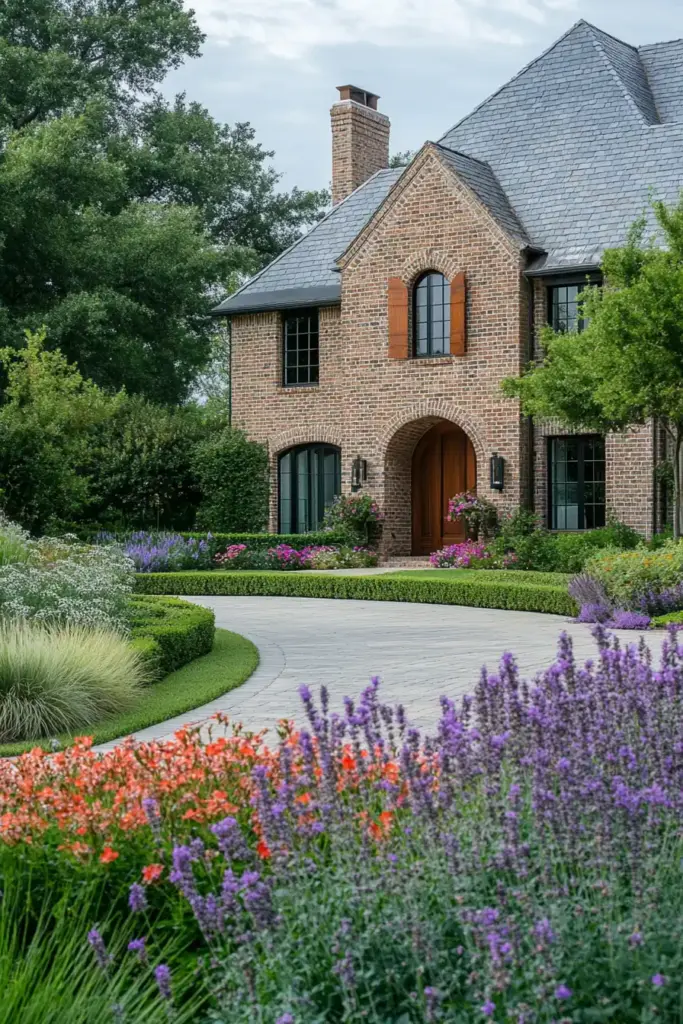
Few flower garden ideas are as charming and iconic as the English garden. Known for its “organized chaos,” this style blends a rich variety of blooms in seemingly wild arrangements that are actually thoughtfully designed to support pollinators and seasonal color.
🌷 Key Elements:
- Perennials in shades of pink, purple, and blue (think delphinium, foxglove, and coneflowers)
- Pollinator-friendly plants with shallow blooms and rich nectar stores
- Dense, layered beds surrounding traditional architectural elements
🏡 Design Tips:
- Mix tall and low plants randomly rather than in neat rows to achieve a natural, overflowing look.
- Repeat plant varieties for cohesion, but vary heights and textures for visual depth.
- Use narrow garden paths to meander through the flower beds, inviting exploration and creating intimacy.
The English garden style is perfect for front yards or cottage settings and works beautifully when matched with stone walls, wrought iron fences, or vintage planters. It’s all about abundance, fragrance, and creating a nostalgic, storybook-like environment.
11. Inspire with a Cottage Garden Full of Heirloom Charm
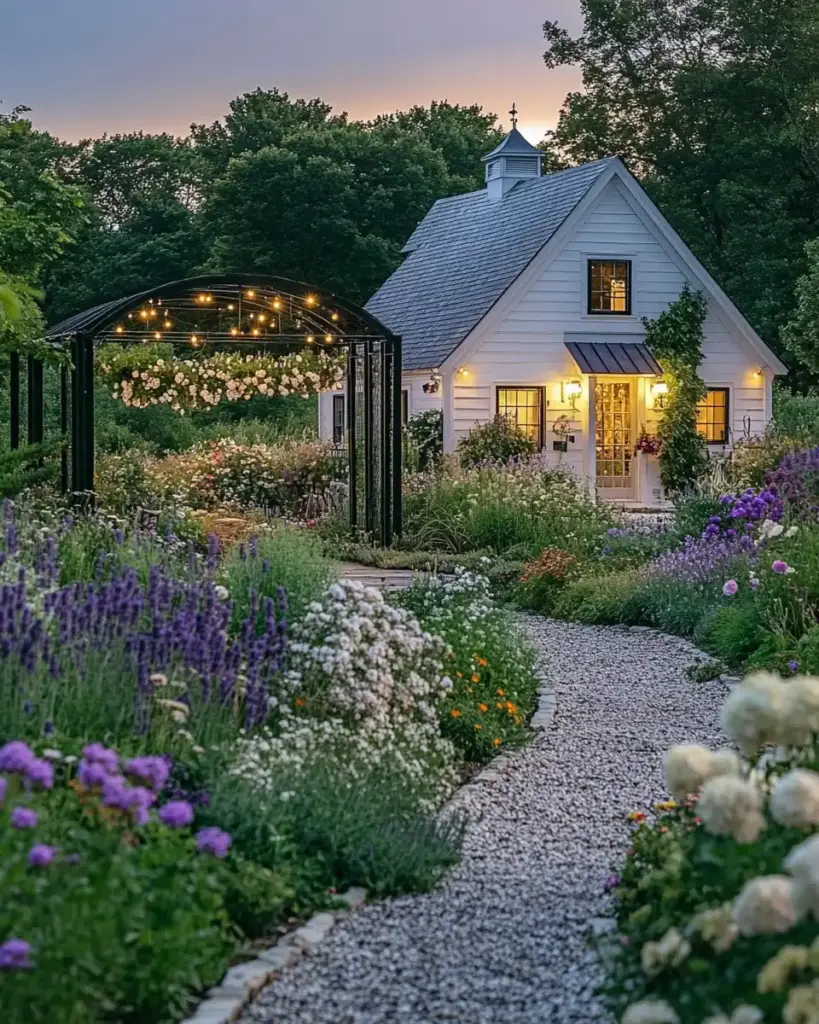
If you love gardens that feel nostalgic, relaxed, and a bit whimsical, cottage gardens are one of the most heartwarming flower garden ideas to explore. Bursting with old-fashioned blooms and layered textures, these gardens embrace imperfection and invite nature to spill over in the most enchanting ways.
🌼 Key Elements:
- Lavender, geraniums, and hollyhocks for fragrance, height, and softness
- Heirloom roses with romantic blooms and vintage appeal
- A warm, restrained color palette (white, blush pinks, rich reds) to maintain cohesion
🪻 Design Tips:
- Repeat flower types throughout borders or beds to give your garden visual rhythm.
- Use winding paths, weathered wood fences, or rustic trellises to complete the look.
- Let plants intermingle naturally rather than spacing them too precisely—cottage gardens thrive on informality.
This style suits both large and small spaces and works particularly well near porches or patios, where its fragrance and visual charm can be enjoyed up close. It’s also a favorite among pollinators like bees and butterflies, making it as functional as it is beautiful.
12. Go for Raised Garden Beds for Structure and Simplicity

When it comes to practical yet stylish flower garden ideas, raised beds offer a clean, organized solution that suits both novice and experienced gardeners. Whether you’re dealing with rocky soil or just prefer a neater layout, raised beds bring structure to your landscape while showcasing your favorite blooms.
🌸 Key Elements:
- Concrete planters for durability and a contemporary look
- White and yellow blooms (like daisies, marigolds, or alyssum) for brightness and contrast
- Compact perennials or annuals suited to confined planting areas
📐 Design Tips:
- Use symmetrical layouts or staggered heights to add dimension to your garden.
- Fill raised beds with rich, well-drained soil to ensure healthy root development.
- Group flowers by color or bloom season for visual impact and extended flowering.
Raised beds are especially helpful in small yards, urban gardens, or areas with poor drainage. They also make planting and maintenance more accessible—great for gardeners with mobility challenges or limited time.
13. Define Borders to Organize and Frame Your Garden
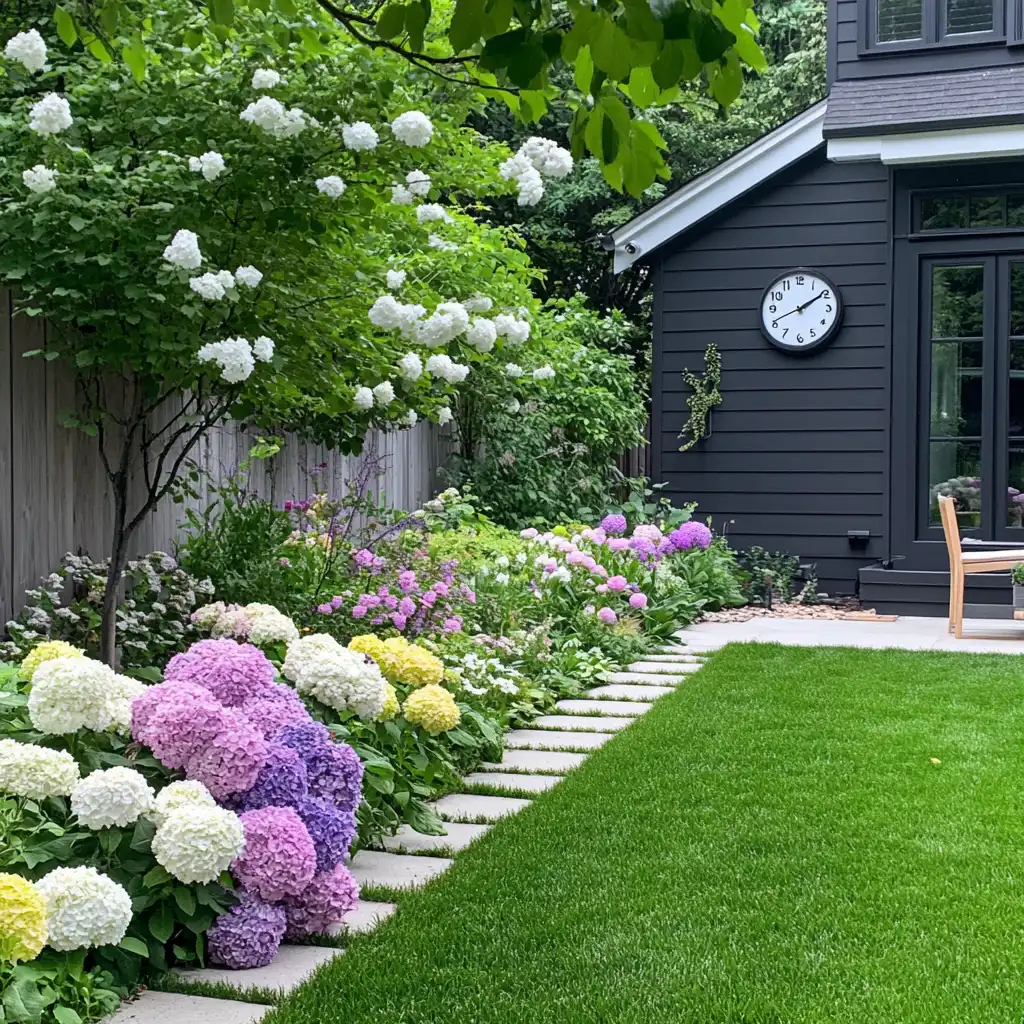
If you’re looking for tidy, well-composed flower garden ideas, defining borders is a simple yet high-impact technique. By outlining spaces with vibrant blooms and varied plant heights, you bring order and purpose to your landscape while allowing each garden section to shine.
🌿 Key Elements:
- Hydrangeas for bold, reliable clusters of seasonal color
- Thalictrum for airy, delicate blooms that contrast with denser flowers
- Pathways or edging materials (stone, brick, or metal) to reinforce structure
🪴 Design Tips:
- Line walkways or garden edges with uniform plantings to guide the eye and create flow.
- Vary plant heights and colors slightly to avoid a too-formal look while still maintaining clarity.
- Consider layering taller flowers in the back and low-growers up front for visibility and cohesion.
Defined borders work beautifully in both modern and traditional landscapes and are especially effective when paired with neatly trimmed lawns or hardscaping. This strategy also makes your garden easier to maintain and visually more polished.
14. Opt for a Wild Look with a Naturalistic Flower Garden
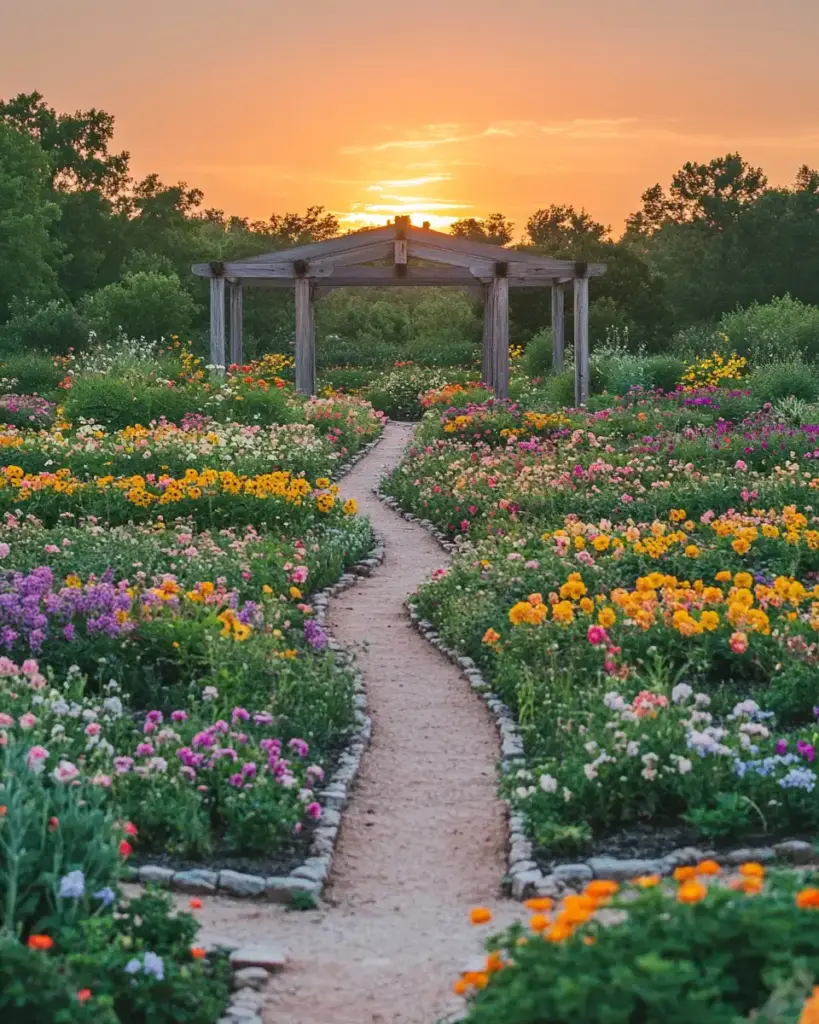
Not all gardens need to be perfectly pruned and polished. If you’re drawn to looser, more organic flower garden ideas, going wild might be just what your space needs. A natural-style garden celebrates untamed beauty, encourages pollinators, and requires less maintenance than formal beds.
🌼 Key Elements:
- Daylilies, dahlias, and gomphrena for bold, colorful variety
- Mixed foliage textures and bloom heights for visual interest
- A pergola or simple garden structure to add vertical focal points
🌱 Design Tips:
- Choose flowers with staggered bloom times to maintain a long display season.
- Let plants spread naturally, only trimming when absolutely necessary.
- Integrate natural elements like boulders, wooden trellises, or native grasses to enhance the setting.
This style suits larger plots or backyard corners that you want to feel more like a meadow or forest edge. It’s ideal for eco-friendly gardening, supporting biodiversity while giving your yard a whimsical, untamed feel.
15. Introduce Planters for Flexibility and Layered Design
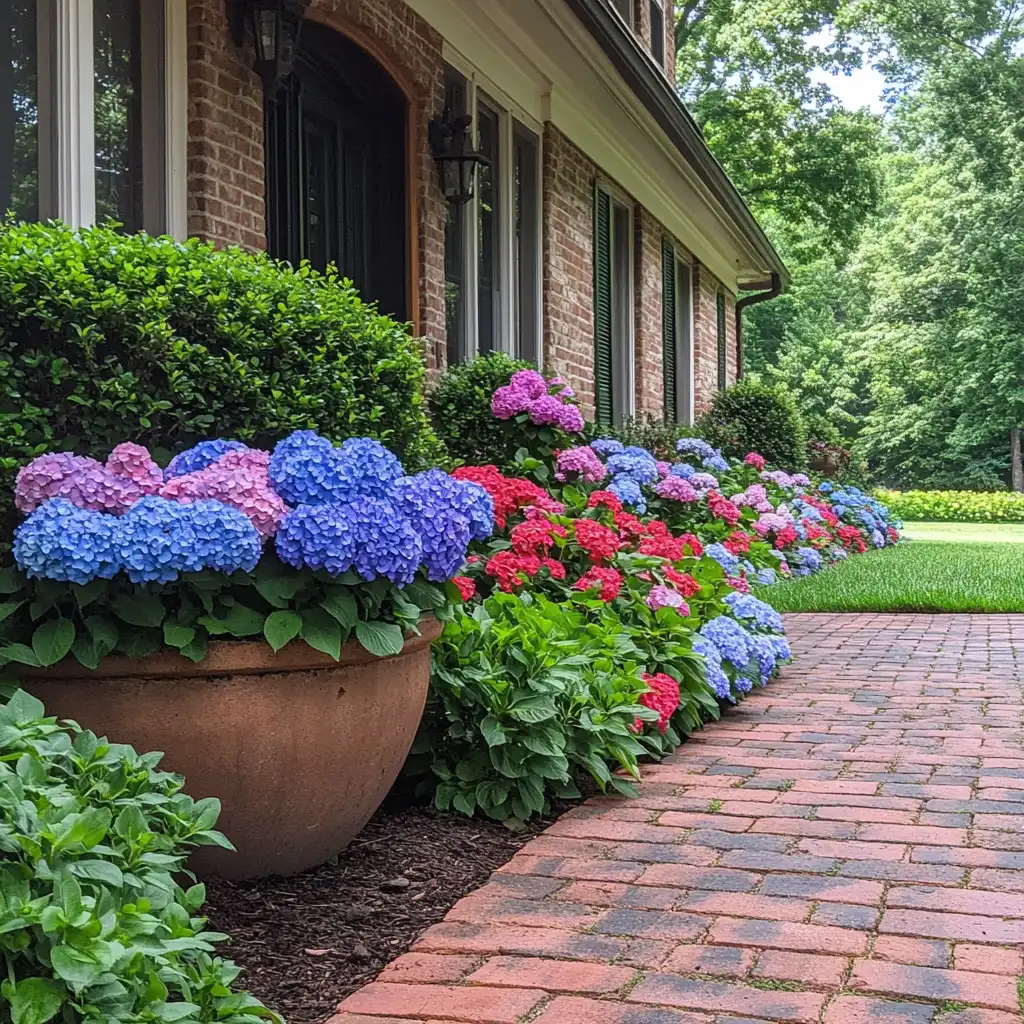
Container gardening is one of the most flexible flower garden ideas, allowing you to add height, color, and visual interest wherever you need it. Whether your space is limited or you just want to experiment with combinations, planters are a quick way to refresh and enhance any garden layout.
🌸 Key Elements:
- Petunias for a splash of color and cascading growth
- Hydrangeas nearby for contrast and volume
- Decorative buckets or ceramic pots to complement your garden’s style
🪴 Design Tips:
- Use tall containers to add layers and depth to flower beds or patios.
- Cluster planters in odd numbers for a more natural, balanced look.
- Swap out seasonal blooms throughout the year to keep your space vibrant and current.
This idea is especially useful for renters, small patios, or anyone wanting to test flower combos before committing them to the ground. It also allows for better soil control and easier rearrangement when redesigning your garden.
16. Conceal the Edge with Lush, Overflowing Flower Beds
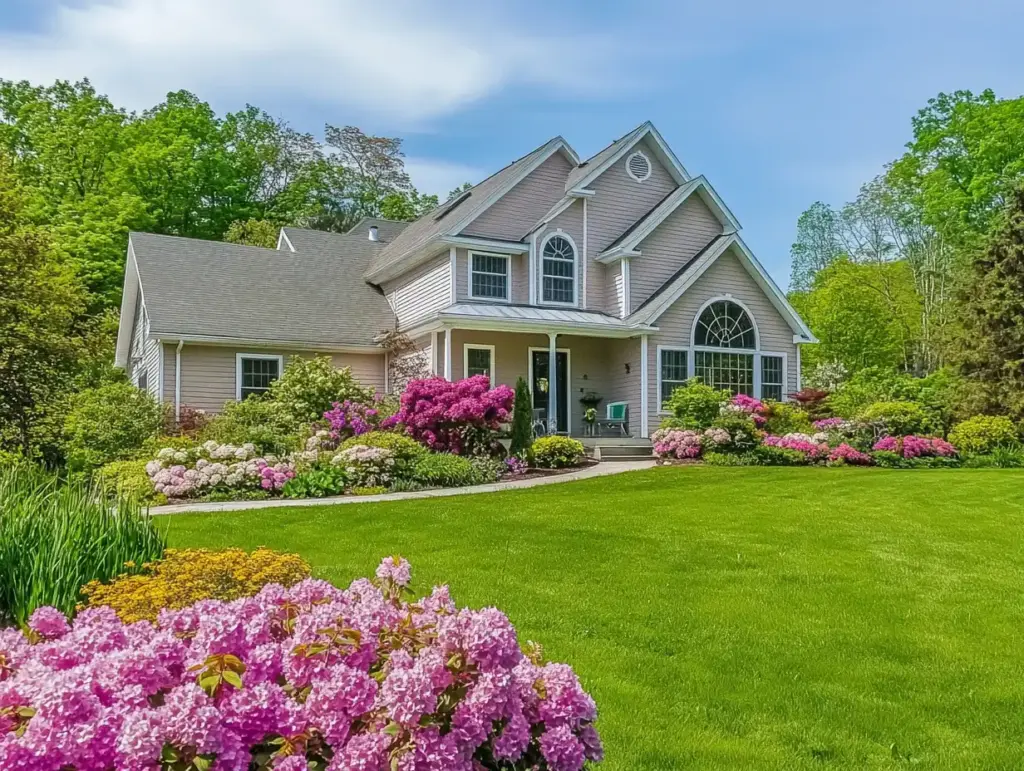
When transitioning between lawn and flower beds, one of the smartest flower garden ideas is to blur the boundaries. Concealing edges with dense greenery and layered blooms softens the landscape, making it feel more natural and immersive.
🌼 Key Elements:
- Cleome (spider flower) for height, motion, and vivid color
- A blend of annuals and perennials in mixed shades—purple, pink, yellow, red, and white
- A hand-spade-edged lawn for a crisp yet organic finish
🌿 Design Tips:
- Use a mix of foliage textures (broadleaf, feathery, spiky) to visually soften the space.
- Let taller plants spill slightly into lawn edges to avoid stark transitions.
- Keep a slightly irregular planting pattern to mimic nature while maintaining structure.
This technique is excellent for garden beds that border open lawn, patios, or driveways. It not only boosts visual appeal but also helps integrate hard and soft landscaping elements seamlessly.
17. Consider a Monotone Look for Modern Elegance
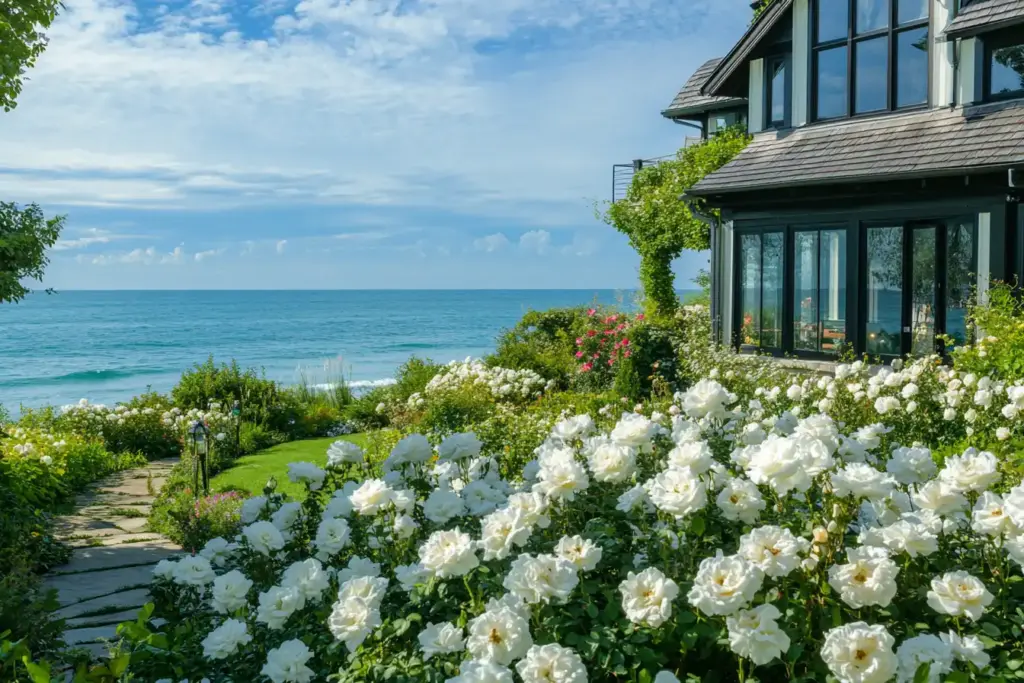
If you prefer a minimalist aesthetic, monotone garden designs offer a sleek and sophisticated take on traditional flower garden ideas. Using a single color—or variations of one hue—creates cohesion and makes a powerful visual impact, especially when paired with modern architecture.
🤍 Key Elements:
- White impatiens for their clean, luminous blooms and shade tolerance
- Neutral hardscaping like stone steps or gravel paths for contrast
- Simple, geometric planting patterns to enhance symmetry and order
🏡 Design Tips:
- Use mass plantings of one flower variety for bold, uninterrupted swaths of color.
- Echo the tones of your home’s exterior to create a harmonious visual flow.
- Pair with dark mulch or green foliage for contrast that makes the monochrome pop.
This approach works well in contemporary or minimalist gardens and is particularly effective along entryways or terraces where clean lines are a defining feature. Monotone doesn’t mean boring—it means bold with intention.
18. Make it Formal with Structured Elegance
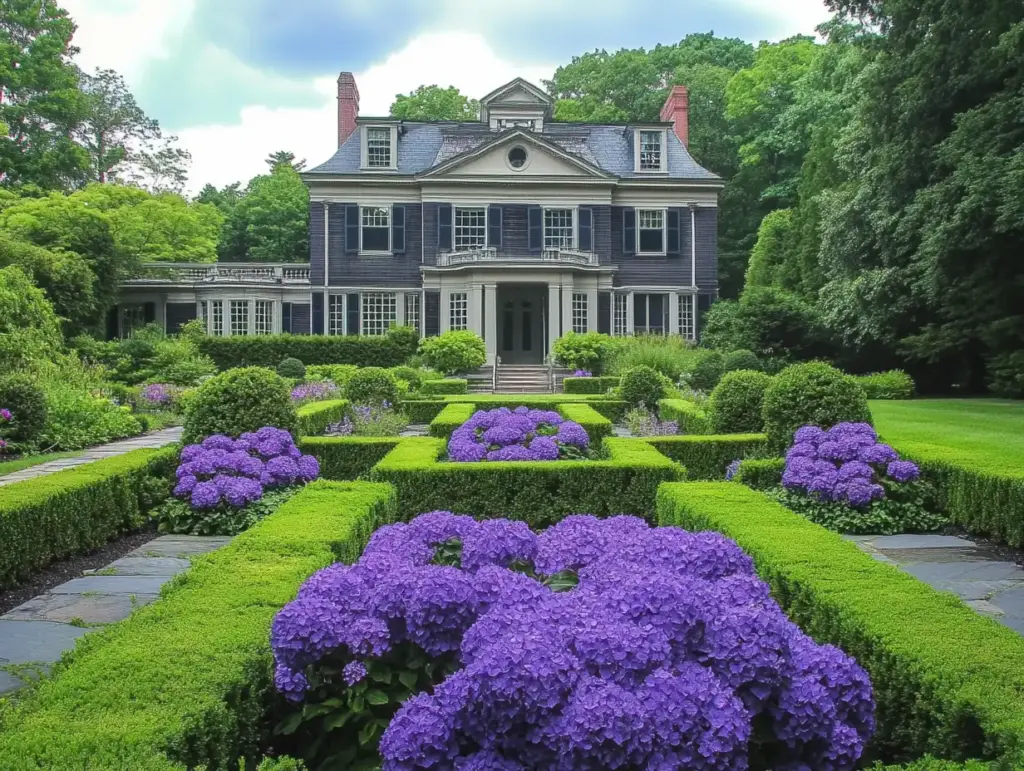
For those who love refined, symmetrical layouts, a formal flower garden is one of the most polished flower garden ideas you can try. It combines clean lines, geometric shapes, and carefully selected blooms to create a timeless and luxurious outdoor space.
🌸 Key Elements:
- Neatly clipped hedges (like boxwood or privet) to frame and divide garden sections
- Purple Cleome, hydrangeas, and clematis for structure, height, and color variation
- Pathways or symmetry-based layouts to enhance formality
✨ Design Tips:
- Stick to a restrained color palette—typically 2–3 hues—to maintain a cohesive and calm aesthetic.
- Use topiary or symmetrical planting to guide the eye and emphasize order.
- Incorporate vertical elements (like trellises or obelisks) to anchor beds and elevate vining plants.
This style is perfect for front yards, courtyard gardens, or large formal estates. It pairs beautifully with classical architecture and is an excellent way to make your landscaping feel intentional, luxurious, and enduring.
🌼 Frequently Asked Questions About Flower Garden Ideas
❓What flowers are best for beginners to plant in a flower garden?
Some of the easiest flowers for beginners include marigolds, zinnias, petunias, and cosmos. These are hardy, require minimal maintenance, and bloom reliably throughout the growing season.
❓How do I plan a flower garden layout?
Start by assessing your space’s sunlight, soil, and drainage. Choose a color scheme, decide on a layout (border, bed, or raised), and select plants with staggered bloom times for continuous color. Use taller plants in the back, medium-height in the middle, and low-growing varieties in the front.
❓How can I make my flower garden bloom all year?
To keep color in your garden year-round, combine spring bulbs, summer perennials, fall annuals, and winter-interest plants like ornamental grasses or evergreen shrubs. Rotating seasonal containers is also a great way to extend interest.
❓What is the easiest way to maintain a flower garden?
Use mulch to suppress weeds and retain moisture, water early in the morning, and deadhead spent blooms regularly. Choose low-maintenance perennials and native plants that thrive in your climate for less upkeep.
❓Can I mix vegetables and flowers in one garden?
Absolutely! This is called a potager garden. Pairing flowers like marigolds, nasturtiums, or alliums with veggies can deter pests and attract pollinators—plus, it looks beautiful.
🌿 Conclusion
Whether you’re drawn to wild, naturalistic planting or carefully composed symmetry, there’s a world of inspiring flower garden ideas waiting to transform your landscape. By understanding your space’s needs—light, soil, and style—and applying creative design techniques, you can create a garden that feels like a true outdoor escape. For added structure and ease of care, explore the benefits of perennials that bloom all year, or discover how to incorporate flower beds in the front yard for maximum curb appeal.

